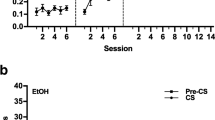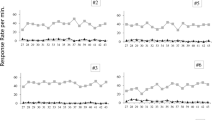Abstract
The study examined the effects of cocaine on learning and performance of a classically conditioned heart rate (HR) discrimination in rats involving two auditory conditioned stimuli (CSs). In the discrimination protocol, one CS (CS+) was paired with the shock unconditioned stimulus (US) on a consistent basis and the other CS (CS−) was always presented alone. Four groups received an IP injection of 1, 3, 10, or 30 mg/kg cocaine and a fifth group received saline. Shortly after the injections, all groups were given six CS-alone trials, followed by 24 randomly sequenced discrimination conditioning trials (12 CS+ and 12 CS−). Approximately 72 h later, all groups were given six test trials with each CS in the absence of cocaine to evaluate the presence or absence of discrimination learning. All cocaine groups showed impaired discrimination performance on the discrimination conditioning trials, reductions in early pretest CS-alone responses, and reductions in resting HR. However, on the non-drug test trials discrimination performance was normal in all cocaine groups. The results established that in spite of major changes in HR dynamics, learning of the HR discrimination was not affected by cocaine but that cocaine did interfere with the performance of the discrimination. Except for the highest 30 mg group, the performance decrement appeared to be related to a cocaine-produced reduction in the capacity to inhibit bradycardia responding to the safe CS−. It was suggested that this loss of inhibitory control may have been due to cocaine changes in a corticothalamic pathway that controls inhibition of bradycardia to a safe CS−.
Similar content being viewed by others
References
Evans EB, Wenger GR (1990) The acute effects of caffeine, cocaine andd-amphetamine on the repeated acquisition responding of pigeons. Pharmacol Biochem Behav 35[3]:631–636
Fitzgerald RD Martin GK, O'Brien JH (1973) Influence of vagal activity on classically conditioned heart rate in rats. J Comp Physiol Psychol 83:485–491
Fitzgerald RD, Martin GK, Hoffman JW (1975) Classical conditioning of heart rate in rats using direct vagal stimulation as a US. Physiol Behav 14:449–456
Fitzgerald RD, Hatton DC, Foutz S, Gilden E, Martinsen DM (1984) Effects of drug-induced changes in resting blood pressure on classically conditioned heart rate and blood pressure in restrained rats. Behav Neurosci 9:820–829
Foote SL, Bloom FE, Aston-Jones G (1980) Impulse activity of coeruleus neurons in awake rats and squirrel monkeys is a function of sensory stimulation and arousal. Proc Natl Acad Sci USA 77:3033–3037
Gritzke R, Church MW (1988) Effects of cocaine on the brain-stem auditory evoked potential in the Long-Evans rat. Electroencephalogr Clin Neurophysiol 71:389–399
Harris GC, Fitzgerald RD (1991) Locus coeruleus involvement in the development of classically conditioned bradycardia. J Neurosci 11[8]:2314–2320
Hatton DC, Foutz SR, Fitzgerald RD (1984) Baroreceptor involvement in classically conditioned heart rate responses of restrained rats. Physiol Behav 33:31–35
Herning RI, Jones RT, Hooker WD, Tulunay FC (1985) Information processing components of the auditory event related potential are reduced by cocaine. Psychopharmacology 87:178–185
Introini-Collison IB, McGaugh JL (1989) Cocaine enhances memory storage in mice. Psychopharmacology 537–541
Janak PH, Martinez JL Jr (1992) Cocaine and amphetamine facilitate retention of jump-up responding in rats. Pharmacol Biochem Behav 41[4]:837–840
Janak PH, Keppel G, Martinez JL Jr (1992) Cocaine enhances retention of avoidance conditioning in rats. Psychopharmacology. 106:383–387
Jarrell TW, Gentile CG, Romanski L M, McCabe PM, Schneiderman N (1987) Involvement of cortical and thalamic auditory regions in retention of differential bradycardiac conditioning to acoustic conditioned stimuli in rabbits. Brain Res 412:285–294
Kapp BS, Frysinger RC, Gallagher MA, Haselton JR (1979) Amygdala central nucleus lesions: effects on heart rate conditioning in the rabbit. Physiol Behav 23:1109–1117
Lin Y, Morrow TJ, Kiritsy-Roy JA, Terry LC, Casey KL (1989) Cocaine: evidence for supraspinal, dopamine-mediated, non-opiate analgesia. Brain Res 479:306–312
Marshall-Goodell B, Gormezano I (1991) Effects of cocaine on conditioning of the rabbit nictitating membrane response. Pharmacol Biochem Behav 39:503–507
Matsuzaki M, Misra AL (1978) Cocaine and pseudocaine: comparative effects on electrical after-discharge in the limbic system of cats. Brain Res Bull 3[4]:341–347
McCabe PM, Schneiderman N, Jarrell TW, Gentile CG, Teich AH, Winters RW, Liskowsky D (1992) Central pathways involved in classical differential conditioning of heart rate responses in rabbits. In: Gormezano I, Wasserman EA (eds) Learning and memory: the behavioral and biological substrates. Lawrence Erlbaum, Hillsdale N.J., pp 321–346
Ni H, Zhang J, Harper RK, Harper R (1992) Discharge dependencies of amygdala central nucleus neurons to the cardiac and repiratory cycle following local cocaine administration. Eur J Pharmacol 224:157–165
Pitts DK, Marwah J (1987) Electrophysiological actions of cocaine on noradrenergic neurons in rat locus coeruleus. J Pharmacol Exp Ther 240 345–351
Schwaber JS, Kapp BS, Higgins GA, Rapp PR (1982) Amygdaloid and basal forebraine direct connections with the nucleus of the solitary tract and the dorsal motor nucleus. J Neurosci 2 1424–1438
Teich AH, McCabe MP, Gentile CC, Schneiderman LS, Winters RW, Liskowski DR, Schneiderman N (1989) Auditory cortex lesions prevent the extinction of Pavlovian differential heart rate conditioning to tonal stimuli in rabbits. Brain Res 480:210–218
Yang JC, Clark WC, Dooley JC, Mignogna FV (1982) Effect of intranasal cocaine on experimental pain in man. Anesthes Analg 61:358–361
Yeh SY, Haertzen CA (1991) Cocaine-induced locomotor activity in rats. Pharmacol Biochem Behav 39:723–727
Author information
Authors and Affiliations
Rights and permissions
About this article
Cite this article
Sakamoto, H., Fitzgerald, R.D. Learning versus performance effects of cocaine on discriminative heart rate conditioning in rats. Psychopharmacology 120, 162–168 (1995). https://doi.org/10.1007/BF02246189
Received:
Revised:
Issue Date:
DOI: https://doi.org/10.1007/BF02246189




